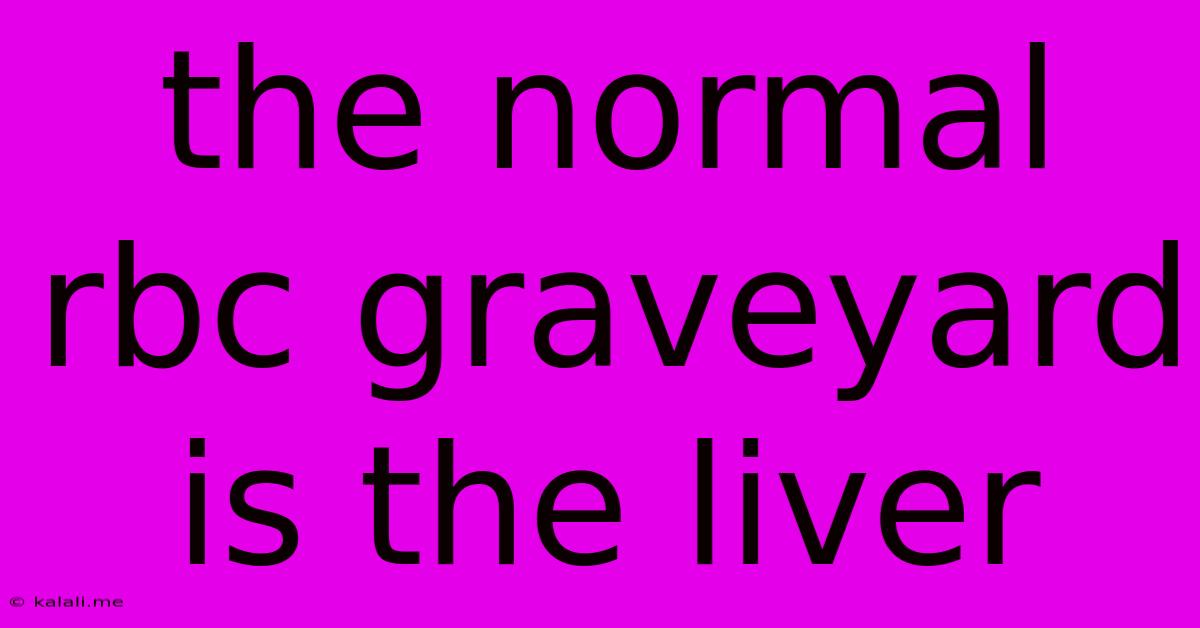The Normal Rbc Graveyard Is The Liver
Kalali
Jun 14, 2025 · 3 min read

Table of Contents
The Liver: The Unsung Hero of Red Blood Cell Disposal
The human body is a marvel of efficiency, constantly renewing itself through intricate processes. One such process, often overlooked, is the disposal of old and damaged red blood cells (RBCs). While many associate bone marrow with blood cell production, the liver plays a critical role as the primary graveyard for worn-out RBCs. This article delves into the fascinating mechanism by which the liver efficiently removes these spent cells, maintaining the health and integrity of our circulatory system.
Understanding the Life Cycle of Red Blood Cells
Red blood cells, essential for oxygen transport throughout the body, have a limited lifespan of approximately 120 days. As these cells age, they become less flexible and more prone to damage, losing their ability to effectively carry oxygen. This damage triggers their removal from circulation. Unlike other cells that undergo apoptosis (programmed cell death) in situ, aged RBCs are selectively targeted and removed by the reticuloendothelial system (RES), primarily residing in the spleen and, most significantly, the liver.
The Liver's Role in RBC Disposal: A Detailed Look
The liver's prowess in RBC disposal stems from its unique anatomical structure and specialized cells within it. Kupffer cells, a type of macrophage residing in the liver's sinusoids (tiny blood vessels), are the key players in this process. These cells are highly phagocytic, meaning they are adept at engulfing and breaking down cellular debris. As aged and damaged RBCs pass through the liver's sinusoids, Kupffer cells recognize and capture them.
The process involves several steps:
- Recognition and Engulfment: Kupffer cells identify aged RBCs through various signals, including changes in cell membrane structure and the presence of specific surface markers. They then engulf these cells through phagocytosis.
- Hemoglobin Breakdown: Once inside the Kupffer cells, hemoglobin, the oxygen-carrying protein within RBCs, is broken down. This process involves the separation of heme and globin.
- Heme Metabolism: The heme molecule is further metabolized into bilirubin, a yellowish pigment. This bilirubin is then conjugated (modified) in the liver to make it water-soluble for excretion.
- Globin Degradation: The globin protein is broken down into its constituent amino acids, which are recycled for protein synthesis elsewhere in the body.
- Bilirubin Excretion: The conjugated bilirubin is secreted into the bile, a fluid produced by the liver that aids in digestion. It is eventually eliminated from the body through the feces, giving feces their characteristic brown color.
The Significance of Liver Function in RBC Recycling
The efficient removal of senescent RBCs by the liver is crucial for several reasons:
- Preventing Hemolysis: The breakdown of RBCs within the liver prevents uncontrolled hemolysis (rupture of RBCs) in the bloodstream, which could lead to harmful consequences.
- Iron Recycling: The iron released during hemoglobin breakdown is recycled and reused in the production of new RBCs, ensuring efficient utilization of this essential mineral.
- Preventing Bilirubin Buildup: The liver's role in bilirubin metabolism prevents its accumulation in the blood, avoiding jaundice and other related complications.
Clinical Implications: When Liver Function is Compromised
When liver function is impaired due to disease (cirrhosis, hepatitis, etc.), its ability to efficiently remove aged RBCs is compromised. This can lead to an accumulation of bilirubin in the blood, resulting in jaundice. Furthermore, impaired RBC clearance can contribute to anemia and other hematological abnormalities.
In Conclusion:
The liver's role as the primary graveyard for red blood cells is a crucial aspect of maintaining overall health. Its efficient disposal of these spent cells contributes to the body's intricate system of recycling and waste management, highlighting its importance beyond its well-known metabolic functions. Understanding this process enhances our appreciation for the liver's vital contribution to haematological homeostasis.
Latest Posts
Latest Posts
-
A Change In Position Is Called
Jun 14, 2025
-
What Is The Frequency Of The Wave Shown Below
Jun 14, 2025
-
Who Wrote Saare Jahaan Se Accha
Jun 14, 2025
-
Find The Measure Of Angle Abc
Jun 14, 2025
-
What Element Has An Atomic Number Of 17
Jun 14, 2025
Related Post
Thank you for visiting our website which covers about The Normal Rbc Graveyard Is The Liver . We hope the information provided has been useful to you. Feel free to contact us if you have any questions or need further assistance. See you next time and don't miss to bookmark.